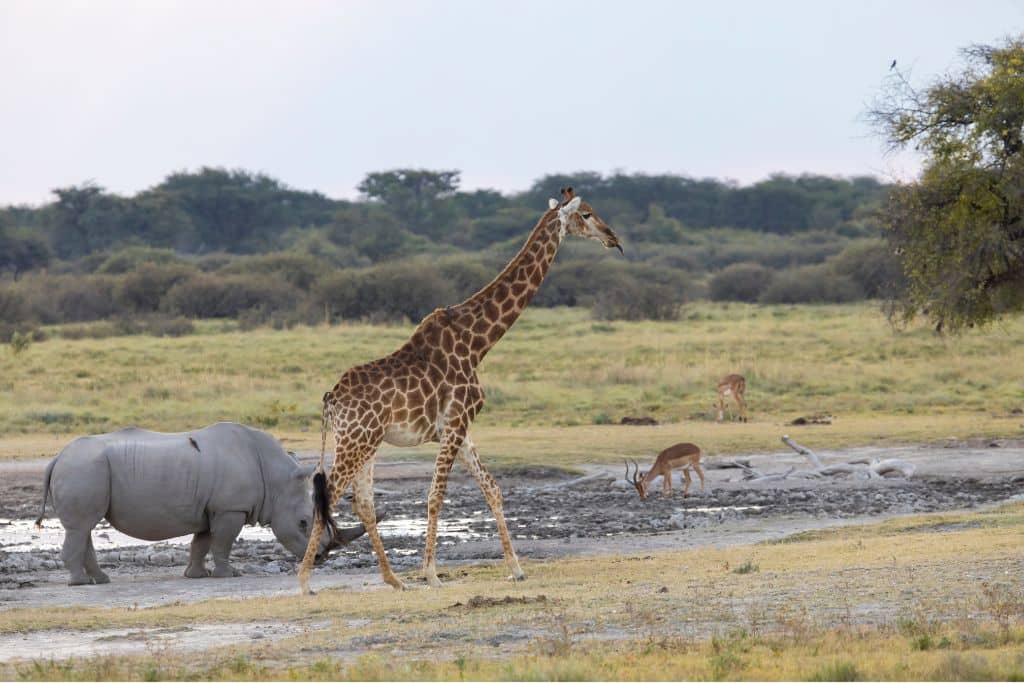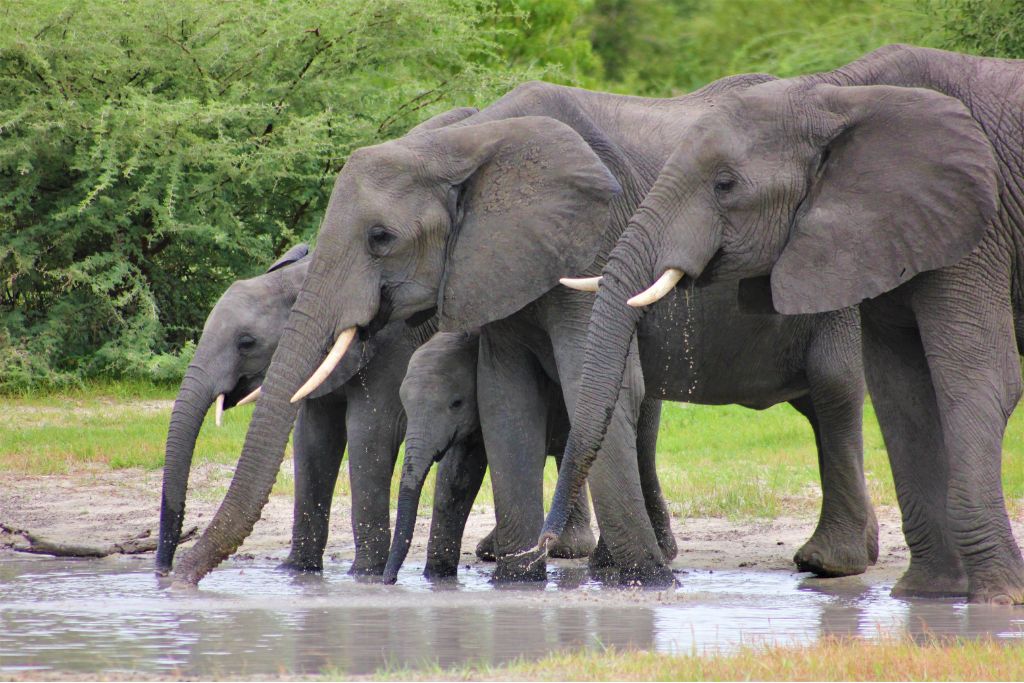In the face of the escalating environmental crisis, attention is turning towards solutions that address multiple challenges. One such avenue of research is the positive relationship between megafauna conservation, biodiversity recovery, and carbon balance. This article examines the ways in which restoring and conserving large mammal populations can also help to mitigate climate change and reduce the risk of fire-related emissions.
—
The environmental crisis facing humankind needs little introduction. The twin pillars of climate change and biodiversity collapse are attracting increasing attention, yet insufficient action. With average global temperatures in 2023 at 1.45C higher than pre-industrial levels and an average global wildlife decline of 69% in the last 50 years, the need for bold action has never been more urgent. It is encouraging therefore to see that interest is growing in solutions which “align biodiversity conservation and recovery with climate change mitigations.”
A 2022 research paper led by ecologists from Oxford University and Aarhus University has shown that, in a variety of biomes and ecosystems, restoring populations of free-roaming megafauna boosts biodiversity levels and dramatically improves carbon dioxide sequestration on conserved land. While there is no clear way to address the myriad environmental issues facing humanity, nature-based solutions that harness the potential of natural processes and use the biosphere’s built-in stabilising mechanisms can certainly help to address multiple challenges.
You might also like: 15 Biggest Environmental Problems of 2024
Restoring Megafauna
Given the extent (and continued expansion) of human activities, it comes as little surprise that wildlife populations are decreasing across the globe. However, data showing the global distribution of mammals is truly shocking.
According to Our World in Data, humans make up 34% of global mammal biomass, while our livestock contributes a staggering 62%. This leaves us with the scarcely believable fact that wild mammals comprise just 4% of the mammal kingdom, and the number is falling. Such a situation poses grave threats to the future of existence, with some scientists warning that we may be on the brink of ecological tipping points which, once passed, will precipitate irrevocable ecosystem collapse.
You might also like: The Tipping Points of Climate Change: How Will Our World Change?
Nevertheless, potential solutions are plentiful.
For instance, the restoration of large populations of free-roaming megafauna comes with a range of benefits, helping not only to reverse biodiversity decline but also to reduce concentrations of atmospheric carbon dioxide (CO2) while providing opportunities for local employment, education, and community engagement.
Large herbivores, such as bison, buffalos, rhinos, and elephants, can be described as ecosystem engineers, creating disturbance, opening ecological niches, and assisting in seed dispersal. These species have often been considered destroyers of habitat, animals that damage the vegetation of an ecosystem to such an extent that they reduce the vegetation’s ability to draw down CO2.
However, this perception has been challenged by discoveries showing that large wild animals have a crucial role in climate change mitigation. Nowhere is this more true than in Sub-Saharan Africa, home to some of the last populations of numerous large herbivores.
Fire Control
Across many Sub-Saharan megafauna habitats, periodic, seasonal fires are a natural component of the ecosystem, often helping certain vegetation species to germinate and removing excess moribund material. However, the reduction in megafauna numbers in these areas has contributed to increased fuel biomass, frequently leading to much larger, more intense and longer-term burns. In many cases, controlled fire management serves to replicate lost natural processes, though this does not need to be the case if such work was undertaken naturally by megafauna.
The dry winter grasslands of Southern Africa often act as a tinder stack, allowing fires to quickly get out of control. By conserving and restoring large herbivore species, a great deal of fire-mitigation work can happen naturally. For instance, buffalos, wildebeests, and white rhinos are bulk grazing species which crop grasses to a level typically too low to support fires, thereby reducing fire spread and intensity as well as the associated increase in CO2 emissions.
Similarly, browsing species like black rhinos, giraffes, and kudus (a spiral–horned, ‘tragelaphus’ antelope) consume potential fuel materials and break up fuel continuity. In addition, large populations of herbivores dig and trample soil while creating trails, pathways, and wallows, all of which help form natural firebreaks and improve overall ecosystem resilience to fire.

A variety of species is beneficial in fire control because different browsing heights, such as the difference between a giraffe and a nyala (another spiral-horned tragelaphus species), can help to reduce crown fires by breaking up vertical fuel continuity. Vertical fuel continuity refers to the unbroken structure of fuel biomass which can transfer fires from ground to canopy level.
Terrestrial Carbon Storage
The argument concerning megafauna and their impact on potential fuel biomass is logical and simple to observe. Perhaps more powerful in the battle against climate change, however, are the invisible benefits provided by large wild herbivores in terms of an increase in soil carbon stocks.
This happens in two ways.
First, carbon is transferred underground in the dung of herbivores. As they consume carbon-rich vegetation, much of this carbon is locked into their dung. Through decay and the activities of coprophagic (or faeces-eating) species, like dung beetles, the carbon is sequestered in the soil. However, it is important to note that not all herbivore species are equal in this regard. The four-chambered stomachs of ruminant species, including buffalos, giraffes and cattle (often farmed on formerly wild lands), produce a great deal of a planet-warming greenhouse gas known as methane. Nevertheless, the rougher digestive tracts of hind-gut fermenters, such as elephants, rhinos and zebras allow much greater quantities of carbon to pass through to their dung. Elephants, for instance, only digest around 40% of what they consume.
Carbon sequestration can also occur if soil quality is improved. This allows greater and more persistent carbon storage capacity, and improved chances of vegetation growth. Vegetation that reaches a mature state helps maximise sequestration, thereby encouraging a positive feedback loop of carbon storage. A higher likelihood of vegetation reaching a mature state helps maximise sequestration.
You might also like: Op-Ed: The Private Sector Must Prioritise Investments in Soil Health
Adaptation to Climate Change
A more nuanced benefit of megafauna is their effect on ecosystem adaptation to climate change, as identified in a 2022 paper. Large-scale disturbance helps increase habitat heterogeneity, creating niches for species of all sizes. It also leads to increased complexity of food webs, improving ecosystem resilience to change.
Moreover, many species of vegetation have evolved alongside large herbivores and now rely on the herbivores for seed dispersal. This happens in several ways.
The hair or fur of large mammals often catches seeds, which are then carried far and wide as the animals move to new areas. The digestive tract of hind-gut fermenters also serves as a transport mechanism, with the seeds of fruits often passing through undamaged and able to germinate in the nutrient-rich dung once defecated. Dispersal is essential for ecosystem success as it allows plant species to travel to areas where conditions may be more favourable and success rates higher.
An Elephantine Effort
While the impact of a rising number of large herbivores is obvious, one is certainly worth investigating in more detail. Undoubtedly one of the most effective “keystone species” on the planet, elephants exert a disproportionately large impact on their immediate ecosystem. This is especially true in the context of climate change mitigation.
Within a forest ecosystem, trees exist on a spectrum of carbon densities. Light wood species have low carbon densities, growing very quickly and out-pacing slower-growing trees in their pursuit of sunlight, while heavy wood species have a far higher carbon density and grow much more slowly. Importantly, heavy wood trees with higher carbon density are able to store more carbon in their wood, making them more favourable than light wood trees when it comes to climate change mitigation.
Forest elephants affect the abundance of plant species on this spectrum by feeding demonstrably more heavily on the more palatable light wood species, thereby reducing fuel biomass while opening more favourable conditions for the heavy wood species to mature. By cutting back the forest, competition amongst trees is reduced, allowing heavy wood trees to flourish.
The latter species has evolved to aid this process by typically producing large, highly palatable fruits. Elephants consume these fruits in large quantities, spreading the seeds of high carbon storage tree species more widely in the forest ecosystem when they defecate. This activity also helps transport the seeds of high carbon storage trees towards potentially better-suited growing conditions, improving growth chances.
Such is the impact of these “gardeners of the forest” that Professor Stephen Blake of Saint Louis University estimates that if elephants went extinct, the rainforests of Central and West Africa would “lose between six and nine percent of their ability to capture atmospheric carbon.”
You might also like: 12 Incredible Facts About Elephants
Finding the Land
It is important to note that there is no ubiquitous positive synergy between megafauna conservation and climate change mitigation. Yet, the science concerning the essential impact of large animal restoration is clear. Where appropriate, restoring populations of large mammals will not only help reinvigorate ecosystems and increase biodiversity levels but also assist in drawing down atmospheric CO2.
However, this will require returning great quantities of land to nature across the globe – a task that can only be achieved with large-scale community engagement and benefits. Without these essential factors, any such project risks alienating locals and damaging communities.
Fortunately, through initiatives like the commitment to save 30% of land and water by 2030 (also known as the “30-by-30” goal) reached at COP15 in 2022, recovering land for nature is on the agenda. If this planet’s land can be protected and large-scale animal conservation continues to find success, such plans will bring economic and social benefits to communities and assist with climate change mitigation, all whilst restoring and conserving wild species and their habitats.
More on the topic: Animating the Carbon Cycle: Earth’s Animals Vital Allies in CO2 Storage

















